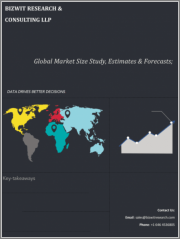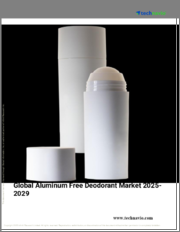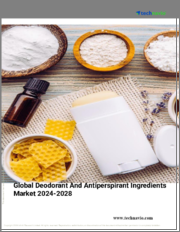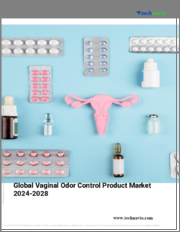
|
시장보고서
상품코드
1269575
세계의 데오드란트 및 제한제 시장 규모 조사 및 예측 : 타입별(알코올, 향료, 항균, 알루미늄염, 기타), 제품 타입별(에어로졸 스프레이, 롤온, 스틱/젤, 기타), 지역별 분석(2022-2029년)Global Deodorant and Antiperspirant Market Size study & Forecast, by Type(Alcohol, Fragrance, Anti-microbial, Aluminum Salt and Others) and by Product Type (Aerosol Spray, Roll-on, Stick/Gels and Others) and Regional Analysis, 2022-2029 |
||||||
데오드란트는 땀의 세균분해에 의한 체취를 없애기 위해 몸에 바르는 물질입니다.
한편, 제한제는 피부의 땀을 억제하는 제품으로, 크림, 파우더, 액체 스프레이 등 많은 제제가 있습니다. 데오드란트제와 제한제가 결합된 제품도 있습니다. 제한제와 데오드란트는 체취를 줄이기 위해 서로 다른 방식으로 작용합니다. 제한제는 땀을 억제하여 효과를 발휘합니다. 데오드란트는 피부의 산성도를 높이는 것으로 효과를 발휘합니다. 퍼스널 케어 제품에 대한 수요 증가와 개인 위생에 대한 의식의 증가가 시장의 성장을 촉진하는 주요 요인이 되고 있습니다.
퍼스널 케어 제품에 대한 수요 증가는 세계의 데오드란트 및 제한제 시장의 성장에 기여하고 있습니다. 예를 들어 2023년 현재 세계 뷰티&퍼스널 케어 시장의 수익은 5,711억 달러로 추정되며, 2023년부터 2027년까지 매년 3.80% 성장했으며, 2027년 말에는 6,629억 8,000만 달러에 달할 것으로 예측됩니다. 또한 시장 관계자 간의 전략적 파트너십과 협력 관계가 높아짐에 따라 비건 데오드란트의 상승은 예측기간 동안 시장에 유리한 성장 전망을 창출할 것입니다. 그러나 환경문제에 대한 우려와 COVID-19에 의한 공급망의 혼란은 2022년부터 2029년까지의 예측기간 동안 시장 성장을 방해합니다.
데오드란트 및 제한제 세계 시장 조사에 고려된 주요 지역은 아시아태평양, 북미, 유럽, 중남미 및 기타 세계 지역입니다. 북미는 주요 데오드란트/제한제 브랜드의 존재와 이 지역에서 남성용 퍼스널 케어 제품의 수요 증가로 수익면에서 시장을 독점하고 있습니다. 한편, 아시아태평양은 비건과 식물 유래의 데오드란트 제품의 보급이 진행되고 소비자 직결형 브랜드의 대두가 진행되고 있기 때문에 예측기간 중에 가장 높은 CAGR로 성장할 것으로 예상됩니다.
이 연구의 목적은 최근 몇 년 동안 다양한 부문과 국가의 시장 규모를 파악하고 앞으로 수년간의 시장 규모를 예측하는 것입니다. 이 보고서는 조사 대상 국가 산업의 질적 및 양적 측면을 포함하도록 설계되었습니다.
또한 시장의 미래 성장을 규정하는 촉진요인과 과제 등 중요한 측면에 대한 자세한 정보도 제공하고 있습니다. 또한 주요 기업의 경쟁 상황과 제품 제공에 대한 상세한 분석과 함께 이해관계자가 투자할 수 있는 미시적 시장에서의 잠재적인 기회도 포함하고 있습니다.
목차
제1장 주요 요약
- 시장 현황
- 세계·부문별 시장 추정·예측, 2019-2029년
- 데오드란트 및 제한제 시장, 지역별, 2019-2029년
- 데오드란트 및 제한제 시장, 타입별, 2019-2029년
- 데오드란트 및 제한제 시장, 제품 타입별, 2019-2029년
- 주요 동향
- 조사 방법
- 조사의 가정
제2장 세계의 데오드란트 및 제한제 시장 정의와 범위
- 조사 목적
- 시장 정의와 범위
- 조사 대상 범위
- 산업의 진화
- 본 조사의 대상이 된 해
- 환율 변환율
제3장 세계의 데오드란트 및 제한제 시장 역학
- 데오드란트 및 제한제 시장의 영향 분석(2019-2029년)
- 시장 촉진요인
- 퍼스널 케어 제품의 수요 확대
- 개인의 위생에 대한 의식의 고조
- 시장의 과제
- 환경 문제
- COVID-19로 인한 공급망의 혼란
- 시장 기회
- 시장 기업 간 전략적 파트너십과 협업 증가
- 비건 데오드란트의 대두가 진행
- 시장 촉진요인
제4장 세계의 데오드란트 및 제한제 시장 산업 분석
- Porter's 5 Force 모델
- 공급기업의 협상력
- 구매자의 협상력
- 신규 참가업체의 위협
- 대체품의 위협
- 경쟁 기업 간의 적대 관계
- Porter's 5 Force 모델에 대한 미래적 접근(2019-2029년)
- PEST 분석
- 정치적
- 경제적
- 사회적
- 기술적
- 주요 투자 기회
- 주요 성공 전략
- 업계 관계자 전망
- 애널리스트의 권고와 결론
제5장 위험 평가: COVID-19의 영향
- COVID-19가 업계에 미치는 전체적인 영향에 대한 평가
- COVID-19 이전과 COVID-19 이후의 시장 시나리오
제6장 데오드란트 및 제한제 세계 시장 : 타입별
- 시장 현황
- 데오드란트 및 제한제 세계 시장 : 타입별, 실적 - 잠재력 분석
- 데오드란트 및 제한제 세계 시장 : 타입별, 추정·예측 2019-2029
- 데오드란트 및 제한제 시장, 하위 부문 분석
- 알코올
- 향료
- 항균제
- 알루미늄염
- 기타
제7장 데오드란트 및 제한제 세계 시장 : 제품 타입별
- 시장 현황
- 데오드란트 및 제한제 세계 시장 : 제품 타입별, 실적 - 잠재력 분석
- 데오드란트 및 제한제 세계 시장 : 제품 타입별, 추정·예측 2019-2029
- 데오드란트 및 제한제 시장, 하위 부문 분석
- 에어로졸 스프레이
- 롤온
- 스틱/젤
- 기타
제8장 데오드란트 및 제한제 세계 시장 : 지역별 분석
- 데오드란트 및 제한제 시장, 지역별 시장 현황
- 북미
- 미국
- 타입별 추정·예측, 2019-2029년
- 제품 타입별 추정·예측, 2019-2029년
- 캐나다
- 미국
- 유럽 데오드란트 및 제한제 시장 현황
- 영국
- 독일
- 프랑스
- 스페인
- 이탈리아
- 기타 유럽
- 아시아태평양의 데오드란트 및 제한제 시장 현황
- 중국
- 인도
- 일본
- 호주
- 한국
- 기타 아시아태평양
- 라틴아메리카의 데오드란트 및 제한제 시장 현황
- 브라질
- 멕시코
- 기타 라틴아메리카
- 세계의 기타 지역
제9장 경쟁 정보
- 주요 시장 전략
- 기업 개요
- Unilever plc
- 주요 정보
- 개요
- 재무(데이터의 입수가 가능한 경우만)
- 제품 개요
- 최근 동향
- Procter & Gamble
- L'oreal Company
- Avon Product Inc.
- Shiseido
- CavinKare Pvt. Ltd.
- Henkel AG & Company KGaA
- Beiersdorf AG
- Godrej Consumer Products Ltd
- Colgate-Palmolive
- Unilever plc
제10장 조사 프로세스
- 조사 프로세스
- 데이터 마이닝
- 분석
- 시장 추정
- 검증
- 출판
- 조사의 특징
- 조사의 가정
Global Deodorant and Antiperspirant Market is valued approximately USD XX billion in 2021 and is anticipated to grow with a healthy growth rate of more than XX% over the forecast period 2022-2029. Deodorant is a substance applied over the body to get rid of body odor due to bacterial breakdown of perspiration. Whereas Antiperspirants are products that reduce sweat or perspiration on the skin, and are available in many formulations including creams, powders, and liquid sprays among others. Sometimes deodorant and antiperspirant are combined in a single product. Antiperspirants and deodorants work in different ways to reduce body odor. Antiperspirants work by reducing sweat. Deodorants work by increasing the skin's acidity. The increasing demand for personal care products and growing awareness towards personal hygiene are key factors driving the market growth.
The rise in demand for personal care products is contributing towards the growth of the Global Deodorant and Antiperspirant market. For instance - as of 2023, the revenue in the global Beauty & Personal Care market estimated at USD 571.10 billion, and the market is projected to grow annually by 3.80% between 2023 and 2027 to reach to USD 662.98 billion towards the end of the year 2027. Also, rising strategic partnership and collaborations among market players and growing emergence of vegan deodorants would create lucrative growth prospectus for the market over the forecast period. However, environmental concerns and supply chain disruptions due to COVID-19 stifle the market growth throughout the forecast period of 2022-2029.
The key regions considered for the Global Deodorant and Antiperspirant Market study includes Asia Pacific, North America, Europe, Latin America, and Rest of the World. North America dominated the market in terms of revenue, owing to the presence of leading deodorants and antiperspirant brands and increasing demand for male personal care products in the region. Whereas Asia Pacific is expected to grow with a highest CAGR during the forecast period, owing to factors such as rising penetration of vegan and plant based deodorant products and growing emergence of direct-to-consumer brands in the region.
Major market player included in this report are:
- Uniliver Plc
- Procter & Gamble
- L'oreal Company
- Avon Product Inc.
- Shiseido
- CavinKare Pvt. Ltd.
- Henkel AG & Company KGaA
- Beiersdorf AG
- Godrej Consumer Products Ltd
- Colgate-Palmolive
Recent Developments in the Market:
- In May 2022, Dove, a brand owned by Unilever plc forays into plant-based deodorant segment, with launch of its first ever natural-origin deodorant range named Dove Care by Plants Deodorant. Dove Care by Plants Deodorant is made with 99% naturally-derived ingredients and is free of aluminum, parabens and baking soda.
Global Deodorant and Antiperspirant Market Report Scope:
- Historical Data 2019-2020-2021
- Base Year for Estimation 2021
- Forecast period 2022-2029
- Report Coverage Revenue forecast, Company Ranking, Competitive Landscape, Growth factors, and Trends
- Segments Covered Type, Product Type, Region
- Regional Scope North America; Europe; Asia Pacific; Latin America; Rest of the World
- Customization Scope Free report customization (equivalent up to 8 analyst's working hours) with purchase. Addition or alteration to country, regional & segment scope*
The objective of the study is to define market sizes of different segments & countries in recent years and to forecast the values to the coming years. The report is designed to incorporate both qualitative and quantitative aspects of the industry within countries involved in the study.
The report also caters detailed information about the crucial aspects such as driving factors & challenges which will define the future growth of the market. Additionally, it also incorporates potential opportunities in micro markets for stakeholders to invest along with the detailed analysis of competitive landscape and product offerings of key players. The detailed segments and sub-segment of the market are explained below.
By Type:
- Alcohol
- Fragrance
- Anti-microbial
- Aluminum Salt
- Others
By Product Type:
- Aerosol Spray
- Roll-on
- Stick/Gels
- Others
By Region:
- North America
- U.S.
- Canada
- Europe
- UK
- Germany
- France
- Spain
- Italy
- ROE
- Asia Pacific
- China
- India
- Japan
- Australia
- South Korea
- RoAPAC
- Latin America
- Brazil
- Mexico
- RoLA
- Rest of the World
Table of Contents
Chapter 1. Executive Summary
- 1.1. Market Snapshot
- 1.2. Global & Segmental Market Estimates & Forecasts, 2019-2029 (USD Billion)
- 1.2.1. Deodorant and Antiperspirant Market, by Region, 2019-2029 (USD Billion)
- 1.2.2. Deodorant and Antiperspirant Market, by Type, 2019-2029 (USD Billion)
- 1.2.3. Deodorant and Antiperspirant Market, by Product Type, 2019-2029 (USD Billion)
- 1.3. Key Trends
- 1.4. Estimation Methodology
- 1.5. Research Assumption
Chapter 2. Global Deodorant and Antiperspirant Market Definition and Scope
- 2.1. Objective of the Study
- 2.2. Market Definition & Scope
- 2.2.1. Scope of the Study
- 2.2.2. Industry Evolution
- 2.3. Years Considered for the Study
- 2.4. Currency Conversion Rates
Chapter 3. Global Deodorant and Antiperspirant Market Dynamics
- 3.1. Deodorant and Antiperspirant Market Impact Analysis (2019-2029)
- 3.1.1. Market Drivers
- 3.1.1.1. Increasing demand for personal care products
- 3.1.1.2. Growing awareness towards personal hygiene
- 3.1.2. Market Challenges
- 3.1.2.1. Environmental concerns
- 3.1.2.2. Supply chain disruptions due to COVID-19
- 3.1.3. Market Opportunities
- 3.1.3.1. Rising strategic partnership and collaborations among market players
- 3.1.3.2. Growing emergence of vegan deodorants
- 3.1.1. Market Drivers
Chapter 4. Global Deodorant and Antiperspirant Market Industry Analysis
- 4.1. Porter's 5 Force Model
- 4.1.1. Bargaining Power of Suppliers
- 4.1.2. Bargaining Power of Buyers
- 4.1.3. Threat of New Entrants
- 4.1.4. Threat of Substitutes
- 4.1.5. Competitive Rivalry
- 4.2. Futuristic Approach to Porter's 5 Force Model (2019-2029)
- 4.3. PEST Analysis
- 4.3.1. Political
- 4.3.2. Economical
- 4.3.3. Social
- 4.3.4. Technological
- 4.4. Top investment opportunity
- 4.5. Top winning strategies
- 4.6. Industry Experts Prospective
- 4.7. Analyst Recommendation & Conclusion
Chapter 5. Risk Assessment: COVID-19 Impact
- 5.1. Assessment of the overall impact of COVID-19 on the industry
- 5.2. Pre COVID-19 and post COVID-19 Market scenario
Chapter 6. Global Deodorant and Antiperspirant Market, by Type
- 6.1. Market Snapshot
- 6.2. Global Deodorant and Antiperspirant Market by Type, Performance - Potential Analysis
- 6.3. Global Deodorant and Antiperspirant Market Estimates & Forecasts by Type 2019-2029 (USD Billion)
- 6.4. Deodorant and Antiperspirant Market, Sub Segment Analysis
- 6.4.1. Alcohol
- 6.4.2. Fragrance
- 6.4.3. Anti-microbial
- 6.4.4. Aluminum Salt
- 6.4.5. Others
Chapter 7. Global Deodorant and Antiperspirant Market, by Product Type
- 7.1. Market Snapshot
- 7.2. Global Deodorant and Antiperspirant Market by Product Type, Performance - Potential Analysis
- 7.3. Global Deodorant and Antiperspirant Market Estimates & Forecasts by Product Type 2019-2029 (USD Billion)
- 7.4. Deodorant and Antiperspirant Market, Sub Segment Analysis
- 7.4.1. Aerosol Spray
- 7.4.2. Roll-on
- 7.4.3. Stick/Gels
- 7.4.4. Others
Chapter 8. Global Deodorant and Antiperspirant Market, Regional Analysis
- 8.1. Deodorant and Antiperspirant Market, Regional Market Snapshot
- 8.2. North America Deodorant and Antiperspirant Market
- 8.2.1. U.S. Deodorant and Antiperspirant Market
- 8.2.1.1. Type breakdown estimates & forecasts, 2019-2029
- 8.2.1.2. Product Type breakdown estimates & forecasts, 2019-2029
- 8.2.2. Canada Deodorant and Antiperspirant Market
- 8.2.1. U.S. Deodorant and Antiperspirant Market
- 8.3. Europe Deodorant and Antiperspirant Market Snapshot
- 8.3.1. U.K. Deodorant and Antiperspirant Market
- 8.3.2. Germany Deodorant and Antiperspirant Market
- 8.3.3. France Deodorant and Antiperspirant Market
- 8.3.4. Spain Deodorant and Antiperspirant Market
- 8.3.5. Italy Deodorant and Antiperspirant Market
- 8.3.6. Rest of Europe Deodorant and Antiperspirant Market
- 8.4. Asia-Pacific Deodorant and Antiperspirant Market Snapshot
- 8.4.1. China Deodorant and Antiperspirant Market
- 8.4.2. India Deodorant and Antiperspirant Market
- 8.4.3. Japan Deodorant and Antiperspirant Market
- 8.4.4. Australia Deodorant and Antiperspirant Market
- 8.4.5. South Korea Deodorant and Antiperspirant Market
- 8.4.6. Rest of Asia Pacific Deodorant and Antiperspirant Market
- 8.5. Latin America Deodorant and Antiperspirant Market Snapshot
- 8.5.1. Brazil Deodorant and Antiperspirant Market
- 8.5.2. Mexico Deodorant and Antiperspirant Market
- 8.5.3. Rest of Latin America Deodorant and Antiperspirant Market
- 8.6. Rest of The World Deodorant and Antiperspirant Market
Chapter 9. Competitive Intelligence
- 9.1. Top Market Strategies
- 9.2. Company Profiles
- 9.2.1. Unilever plc
- 9.2.1.1. Key Information
- 9.2.1.2. Overview
- 9.2.1.3. Financial (Subject to Data Availability)
- 9.2.1.4. Product Summary
- 9.2.1.5. Recent Developments
- 9.2.2. Procter & Gamble
- 9.2.3. L'oreal Company
- 9.2.4. Avon Product Inc.
- 9.2.5. Shiseido
- 9.2.6. CavinKare Pvt. Ltd.
- 9.2.7. Henkel AG & Company KGaA
- 9.2.8. Beiersdorf AG
- 9.2.9. Godrej Consumer Products Ltd
- 9.2.10. Colgate-Palmolive
- 9.2.1. Unilever plc
Chapter 10. Research Process
- 10.1. Research Process
- 10.1.1. Data Mining
- 10.1.2. Analysis
- 10.1.3. Market Estimation
- 10.1.4. Validation
- 10.1.5. Publishing
- 10.2. Research Attributes
- 10.3. Research Assumption













